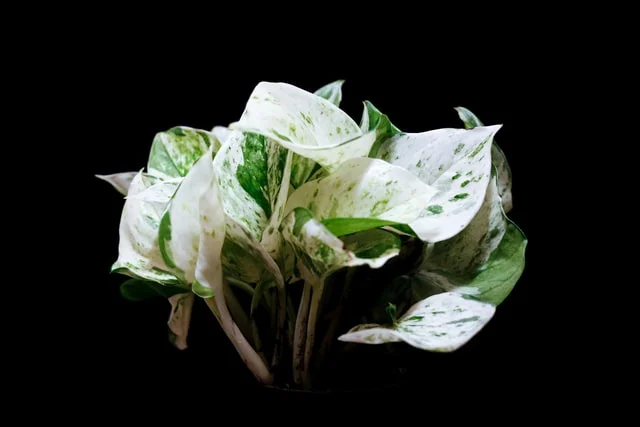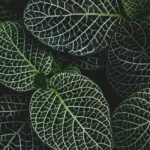Table of Contents
How to Care for Pearls and Jade Pothos
The pearls and jade pothos are one of the species of pothos plants native to the Solomon Islands. It is one of the most durable and popular houseplants for several reasons.
It is a lovely plant that is relatively easy to care for, and it is resilient to environmental factors. In its native location, the pearls and jade pothos plants are known for their tree-climbing habits.
They can grow upwards to 50 feet tall with heart-shaped leaves up to 3 feet long. Of course, the houseplants are considerably smaller in size, and at times, the leaves only reach 6 inches (15cm) in length, while the vines may grow up to 10 feet long.
The size can depend on where it is located, as well as the type of pot it is housed in. For example, whether a small desktop container or a hanging basket that allows for more growth.
The appearance of pearls and jade pothos plant may vary, but they typically develop variegations of yellow, light green, dark green, and even chartreuse.
Indoor environments do not see the flowers develop on jade and pearls pothos, but the beautiful foliage makes for an attractive houseplant.
What does your pearls and jade pothos require?
The pearls and jade pothos houseplant has few specific requirements. It can tolerate various types of environments while staying healthy.
Light requirements
The pearls and jade pothos lighting requirements are flexible. These plants can grow in low-light settings but also do well in medium to bright light.
The best setting is in partial lighting, if possible. Too much bright direct sunlight can burn the leaves or cause the leaves to lose their marbled color.
Temperature requirements
The best air temperature for pearls and jade pothos houseplants range between 18-29 degrees Celsius (65-85 degrees Fahrenheit).
Humidity requirements
While these plants are able to live without much humidity, they tend to grow better with it. Average household humidity of between 40-50% works well for pearls and jade pothos.
Soil requirements
A standard potting mix can be used for this plant. It should be well-draining soil in a container with adequate drainage to prevent waterlogging.
How to Water
Peals and jade pothos houseplants only require small amounts of water. It should only be added when the first inch or so of soil is dry. It is better to miss a watering than it is to add more because of the risk of root rot.
If at all possible, water should be directed towards the bottom of the pot. Too much moisture on the top of the soil can attract pests and encourage the growth of fungal diseases.
How to Fertilize
A diluted form of general fertilizer is suitable for pearls and jade pothos. It should only be given once a month during the growing season, usually between December and May. Fertilizer is not required during the winter months.
Extra tips for pearls and jade pothos
This houseplant has very few care requirements, and those they have are easy to complete. However, there are some other things to watch out for to encourage a longer life span.
Pests and Diseases
The pearls and jade photos plants are resilient to many ailments, but at times, they may have to deal with various pests and diseases, mostly brought on by overwatering or overfertilizing.
The majority of these issues can be treated with the plant’s full recovery, especially when the problem is caught in a timely fashion.
In cases caused by overwatering or overfertilizing, pearls and jade pothos plants will require repotting in fresh soil.
Insecticides and insecticidal soap, specific to the pest, can be used to treat infestations, while fungicides are typically utilized to treat fungal diseases, such as root and stem rot. Bacterial diseases, like the leaf spot, are normally treated with microbial sprays.
- Mealybugs: These pests are attracted to moisture. They are small white or light pink segmented insects that like to feed off the plants. They leave a white wax or cotton-like substance where they feed or settle.
- Aphids: These insects like to suck the sap out of the stems. They leave behind stippled stems where they feed.
- Spider mites: The little spiders are black, white, or red. They tend to live on the underside of the leaves and cover the plant with dusty-looking webs.
- Scale: Scale insects also suck the sap from the plants, removing crucial nutrients. These pests are small, flat, and oval, usually found on the underside of the leaf or at stem joints.
- Pythium root rot: This is a soil-borne fungal disease that damages the roots. It causes the stems to turn brown and black. The leaves may start to turn yellow.
- Bacterial leaf spot: This disease appears as spots of brown or black on the leaves of the pearls and jade plants.
- Rhizoctonia stem rot: This fungal disease causes stem discoloration. Stems will start to turn brown or black. The leaves may also start to turn yellow.
Pruning
There are three main reasons to prune pearls and jade pothos plant.
- To scale back its size.
- To improve its health and encourage growth.
- To gain cuttings for propagation.
In any of these cases, pruning is a simple task. It is possible to prune the vines back as close to 2 inches of the soil without doing damage. Cutting should be done with sterilized sharp instruments such as a blade or pair of pruning shears.
Cuts need to be 1/4 inch (2/3cm) above the leaf. Caregivers must not leave any leafless vines because they will not grow back. Any leafless vines should be completely removed.
Propagation
Propagating peals and jade pothos is done using cuttings. Each cutting needs to be between 4-6 inches (10-15cm) long with at least 4 leaves.
Bottom leaves (not including those needed for propagation) can be removed as they would otherwise be submerged in water or soil. The cuttings can be placed in water or moist soil to develop roots.
Toxicity
Pearls and jade pothos are toxic to humans and pets. It is advised to keep these houseplants out of reach. Gloves can be worn when pruning and repotting to prevent any possible skin irritation.


